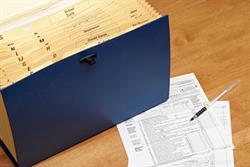Reminder: This is a reporting year! Meet your CPE requirements and make the most of your budget with PICPA’s discounted CPE bundles.
This is the archive of CPA Now blogs posted on the PICPA website through April 30, 2025. Want more recent blogs?
Your New Business Is in the Black: Time to Learn about Quarterly Tax Payments
If you’re running a young business and have finally started to record some profits, congratulations. You now have to start paying estimated quarterly income taxes. Here's what you need to know.
 By Jennifer L. Romberger, CPA, EA
By Jennifer L. Romberger, CPA, EA
Your business bank account had more deposits last month than expenses: you’re finally in the black! Maybe you think, “I no longer have to inject personal funds to keep my business account open. Let’s celebrate!” If you’re in this position with a young business, a cautious congratulations to you. You have reached a critical milestone of success. You have also incurred another expense: estimated quarterly income taxes. And they may be due sooner than you think.
 Estimated taxes are your responsibility as a business owner, and like other tax concepts they can be immensely confusing. Here’s a hit list of action items and concepts to help you prepare to meet with a tax adviser or to calculate your tax obligation yourself.
Estimated taxes are your responsibility as a business owner, and like other tax concepts they can be immensely confusing. Here’s a hit list of action items and concepts to help you prepare to meet with a tax adviser or to calculate your tax obligation yourself.
Learn the Estimate Periods
Most people hear “quarterly” and presume calendar quarters (January through March, April through June, etc.) The reality for federal tax purposes is that these periods are measured accumulatively, and are skewed when compared to normal calendar quarters:
- January through March (Year A) – First estimate due April 15 (Year A)
- January through May (Year A) – Second estimate due June 15 (Year A)
- January through August (Year A) – Third estimate due Sept. 15 (Year A)
- January through December (Year A) – Fourth estimate due Jan. 15 (Year B)
Be sure to check your respective state and local jurisdictions to discover their due dates, which may be different than the federal time frame.
Review Your Prior-Year Federal Returns
How is your business organized? Do you file a return other than Form 1040 to capture your business information? What is the source of your business income as seen on your personal tax return? Is your business gross profit and loss depicted on a Schedule C or do you receive a K-1 from your business? Can you find the line and supporting schedule for your business income or loss filed?
Estimate Your Income
Start with summing your gross revenue for the estimate you’re calculating. (How much you made and when?) By gross, I mean what your customers actually paid you. This figure could be supported by your customer invoice file or deposits in your bank account.
Next, sum your business expenses. This figure would be supported by vendor invoices or withdrawals from your bank account for the same time period. Often, there are more expense transactions than income, so this can be very tedious if you have not embraced a bookkeeping habit.
- Remember, this is an estimate. Expenses can be added in total – meaning categories don’t need to be identified.
- You may want to determine what expenses were incurred in prior years (per your prior year tax returns) and estimate using that benchmark – an expenses over gross revenue percentage, for example. If in a prior year 30 percent of your gross revenue was used on expenses, then you can use that percentage and apply it to the current period you’re estimating. However, check yourself: is anything very different happening in the current year versus prior years? Is it worth quantifying?
Estimate Your Taxes
- Review IRS instructions for estimated tax.
- Seek a professional tax adviser.
- Use your effective rate from your prior-year return – total tax divided by total income. For example, if it’s 30 percent, then estimate 30 percent multiplied by your estimated net income for the period annualized; or, to be really conservative, multiply the percentage by gross income.
- Remember other jurisdictions that may be owed estimated tax payments, such as states and localities.
Send and Record Payment
Send the check, note in your files the date the checked cleared your bank, and maintain a copy of the cleared check in your respective year’s files. Incorporate this support into the source documents you provide to a professional tax preparer or keep in your tax records if you prepare yourself.
Paying estimated income taxes is a killjoy of self-employment that can be daunting and overwhelming. And, as with most things, procrastinating in this area could cost you. Remember: you have reached a place of success if you have income; now you have to adjust your budget for income taxes. Ah, the joys of business ownership!
Jennifer L. Romberger, CPA, EA, is controller and registered securities representative at Long Financial Group in Blue Bell, Pa., concentrating on individual and small-business investments, taxes, and accounting. She can be reached at jennifer@longfg.com.

